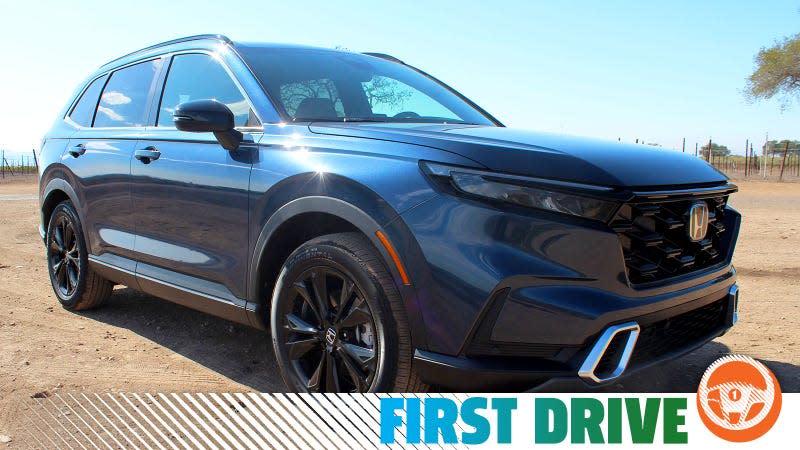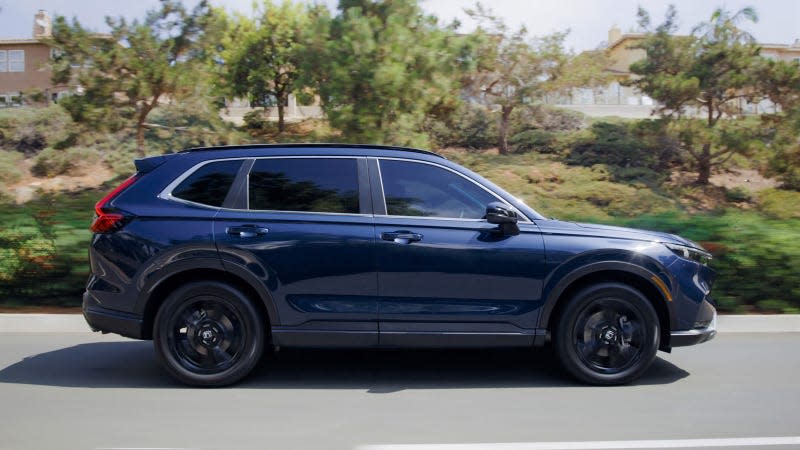The 2023 Honda CR-V Hybrid Is the Obvious Choice for Most Americans

In 2021, the CR-V was Honda’s best-selling product here in America. It was the brand’s top-selling model in 2020 and 2019, too. In fact, it’s been Honda’s best-selling vehicle here in the U.S. for almost every one of the past 20 years. So when the time comes to update the CR-V, it’s a pretty important task for Honda and its engineers.
The sixth generation CR-V brings a new design, new cabin, and the choice between Turbo and Hybrid variants. The Hybrid gives you improved gas mileage, interior upgrades and a driving experience that, together, make it increasingly hard to recommend any other CR-V variant. Let me explain.
Read more
(Full disclosure: Honda flew me out to Santa Barbara and provided me with a hotel room, food and beverages while I chatted with engineers and drove the all-new CR-V Hybrid.)
The 2023 Honda CR-V Hybrid: What Is It?

The Honda CR-V Hybrid: a profile.
In case you’ve been driving around with your eyes closed for the last 25 years, the Honda CR-V is the Japanese automaker’s midsize SUV. It launched in America in 1997 and has been a hit basically ever since. Over the ensuing 25 years, it spawned five generations, and a hybrid model was added to the range in 2020.
This is the sixth-generation CR-V, which will begin hitting the road in 2023. The new model boasts a fresh design, a more spacious interior and a choice between a 1.5-liter Turbo model and an all-new hybrid setup. The hybrid model comes in either front-drive or all-wheel drive Sport trim, or the top-of-the-range AWD Sport Touring, which is the model I drove.

Tailights, Jalopnik readers like those, right?
No matter which model you chose, the first change that you notice is the design. At times, Honda’s styling has felt a little lost in recent years, but the company has been doing a good job of bringing cohesion back to the range with updates to models like the Civic and HR-V. This continues with the new CR-V, I’m pleased to say.
Gone is the curvy, big-chinned look of the fourth and fifth generation. Now, Honda is all about clean lines and sharp angles. At the front, there’s a longer hood, a cross-hatch grille and a new headlight array, which gives the CR-V an angry stare.
In profile, the roofline has been flattened and there’s a sharper angle to the rear end, which also loses the weird protruding taillights of the previous generation. Honda did keep the split design that sees the taillights flank the tailgate and fork off at 90 degrees. It’s an updated LED array that looks neat and new while keeping the back end familiar.
All these new body panels and design updates help to mask the fact that the new CR-V is bigger than the outgoing model. The wheelbase is 1.6 inches longer and the whole car has gained an extra 2.7 inches in length. The new CR-V is also 0.4 inches wider than the previous generation.

Black leather and contrast stitching is always a neat look.
This gave Honda space to redesign the cabin, which executives said was the first priority. There’s a new, larger center console screen, redesigned seats and improved soundproofing throughout the cabin.
On top of all this, there’s also a nice new set of black, 19-inch alloy wheels for the Sport Touring model and some new paint colors, including the canyon river blue metallic finish you see here.
2023 Honda CR-V Hybrid: What’s Under the Hood?

Make it hybrid.
On the Turbo models, Honda updated the 1.5-liter turbocharged four-cylinder familiar from last year’s model. Capable of producing 190 hp, that motor can be ordered with either front- or all-wheel drive in both the EX and EX-L trim levels. In each case, you have just one choice when it comes to transmissions: a CVT.
But the big talking point here is the Hybrid, which comes with an all-new powertrain in ‘23. Both the Sport and Sport Touring variants come with a 2.0-liter four-cylinder and a two-motor hybrid setup that produces a total of 204 hp. That’s three more horses than the old model and 14 more than the 2023 Turbo, making the new hybrid the most powerful CR-V variant ever.
The front-drive hybrid CR-V gets an EPA rating of 40 mpg combined, while the all-wheel drive model loses 3 mpg. Over my day driving the AWD Sport Touring model, I didn’t quite reach that number. In the morning, when I was working my way through the hills and valleys of Southern California, I topped out at 31.3 mpg. The afternoon, which had a little more highway and city-center driving (where regenerative braking pays off), peaked at 33.5 mpg.
To aid that economy, paddles on either side of the steering wheel allow you to switch from full one-pedal driving down to just a hint of regenerative braking.

 Yahoo Autos
Yahoo Autos 